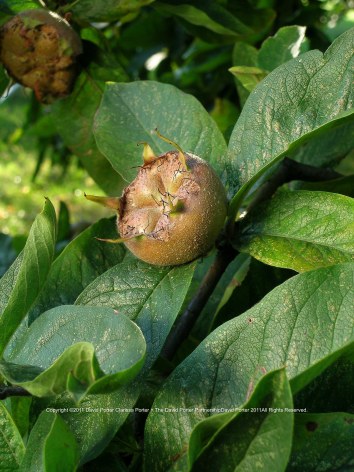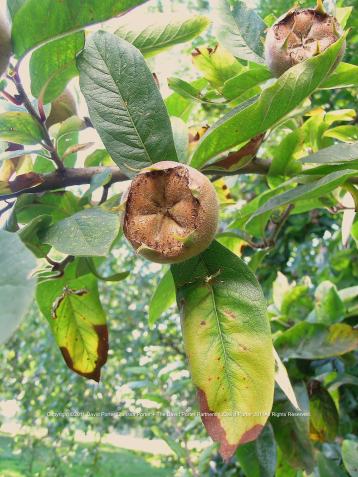I’ve just finished making some Medlar Jelly from fruit gathered in my local park. Medlars are forgotten and neglected now like quince and mulberries, but John Evelyn had Medlar trees in his Deptford orchard, as mentioned in his ‘Directions For the Gardiner at Sayes Court‘.
When you find a Medlar tree, say in the Summer, you watch and wait. And wait… Around the middle of October you’ll still be waiting, and watching. Traditionally Medlars are picked at the end of November, after the first hard frost. David Pennel from the National Fruit Collection at Brogdale reckons it is better to pick the fruit at the end of October. “If you leave them on the tree to blet, they may become infected with a fungal rot. You won’t know they have been affected, but the fungus will taint anything you make with the Medlars. Just one infected fruit will taint everything.” They have about 8 trees at Brogdale, and sell all the fruit they produce. “In a good year we’ll sell 30 – 40 kilos per tree, in a very good year we might get 100 kilos from a single tree.”
Dan Neuteboom who grows and sells the trees from his nursery in Norfolk says that people only buy them for the blossom, not the fruit. He sells about 40 trees a year, of about 4 different varieties. Nigel Slater planted a Medlar in his garden, along with Quince, Mulberry, and Cobnut. He said he was “captivated by the romance and mystery… a fruit shot through with visions of walled Medieval gardens…How could anyone resist?”
The medlar is the Benny Hill , the Monty Python, the Julian Clary and the Blackadder of fruit. Their medieval name is ‘open-arse’, but they have other names: ‘granny’s arse’, and in France cul de chien, the ‘dog’s bottom’! An 18th Century essay described them: “A fruit, vulgarly called an open arse; of which it is more truly than delicately said, that it is nevre ripe till it is as rotten as a turd, and then it is not worth a fart.”
Widow Medler was a character in Thomas Middleton’s Jacobean play ‘A Trick To Catch the Old One.‘ Medlars were common sexual innuendo in Elizabethan and Jacobean plays, Shakespeare used medlars for smutty laughs in four of his plays. In Romeo and Juliet he has Mercutio nudge and leer to Romeo “Now will he sit under a medlar tree, and wish his mistress were that kind of fruit as maids call medlars when they laugh alone. An open-arse and thou a poper’in pear!” He went to town with the triple entendre of a ‘poper’in pear.’ Poper’in pear was a reference to the shape of a man’s genitalia, and there’s the obvious ‘pop-her-in’, and ‘pop’ as in ‘pop goes the weasel’, a reference to orgasm. Shakespeare wasn’t the only writer to succumb to the temptation of a cheap laugh from the pit at The Globe. A few centuries earlier Chaucer wrote in The Reeve’s Tale, “if I fare as dooth an open-ers…till we be roten can we not be rype“.
Chaucer was refering to the apparent contradiction of rotten ripeness, so did DH Lawrence:
Comes out of your falling through the stages of decay:
Stream within stream.
Something of the same flavour as Syracusan muscat wine
Or vulgar Marsala.
Though even the word Marsala will smack of preciosity
Soon in the pussy-foot West.
What is it?
What is it, in the grape turning raisin,
In the medlar, in the sorb-apple.
Wineskins of brown morbidity,
Autumnal excrementa”
Medlars are eaten when they appear rotten, bletted is the word used for ripe medlars. When they first appear on the tree they are about the size of a large walnut and hard and inedible. If you cut one the flesh will be white like a very hard apple, and bitter.
As they age the flesh softens, browns and becomes juicy. If you squeeze a bletted medlar the juice will ooze from the paper-thin skin. The best way to eat a bletted medlar is to break the skin and suck out the flesh, it tastes somewhere between a date and dry apple sauce, with a rumour of cinnamon. The taste is totally unique and delicious. To make more of them you’ll have to make them into fruit cheese, comfits, or a tart. Perhaps the easiest recipe is Medlar Jelly.
They are related to the rose and the hawthorn, and in ancient times the wood was used to make spear points. Basque shepherds carry a stick called a makhila, made from the Medlar tree. The Malika is carved on the living tree, left for a year then cut down and heated. Then for a further ten years (!) the stick is alternately soaked in a secret solution and rubbed with pork fat. One end has a steel tip, and the other a stiletto blade concealed by a silver handle engraved with the owners name.
This recipe is adapted from “The Complete Cook” by Nell Heaton, published in 1946, old recipe books are the places to find medlar recipes. It is a simple recipe though you really need a thermometer. Nigel Slater suggests adding lemons and apples, 1 lemon cut into six pieces and half an apple per 450g medlars , they help the jelly to set, or you could use quince for the same reason. Alternatively you can add some hard medlars, about one third of the weight of the bletted medlars. Medlar jelly goes well with game and mutton, and with cheese and walnuts. From my original 3.5 kg I ended up with just under 2 kg of usable bletted medlars.
Medlar Jelly
Preparation time: 5 minutes
Cooking time: 60 – 90 minutes
ingredients:
(the following amounts assume 450 g Medlars, adjust to scale)
450 g Medlars, bletted, ripe, soft and undamaged.
300 ml water
350 g sugar
method:
Wipe the fruit with a clean dry cloth, then:
Either cut them into pieces, or as I did place them whole into a pan
with some water, 300 ml water to each 450 g fruit so the water just covers them. Bring to a boil then simmer, and wait till they become pulp. Avoid stirring, but you could press down onto the fruit with the back of a serving spoon, this may take up to an hour.
Then using a clean Jelly Bag or a piece of muslin, strain the liquid through the bag slowly. Don’t squeeze the bag! Patience! You want the jelly to be as clear as possible. Measure the juice then return to a clean pan, and for each 300 ml of liquid add 350g sugar. Boil the mixture hard and uncovered, use a thermometer to heat till the ‘jam’ setting is reached (104C), when the acid and pectin reacts with the sugar which will make jelly when the liquid cools. Should be around 4 – 5 minutes. Skim off any scum which I neglected to do with my first batch, don’t worry if you forget! Then pour into warm jars. Leave to set, then cover. The jelly will be an unexpected reddish colour and taste unlike anything else!
©2011 David Porter.








December 3rd, 2011 at 17:14
You know, despite being an avid forager I’ve still never found a medlar tree?
December 3rd, 2011 at 18:29
Well I don’t suppose they’re all that common, but local councils plant them because they’re small-ish and decorative. My local council contractor has planted two more this year, now there’s 3 in the park! Then through the local newsletter I heard of two mature medlars I didn’t know about in a front garden bordering the park. The owners were asking for planning permission to trim and reduce them (round here we have to have permission to breath).
December 11th, 2011 at 17:18
I just love the way you combine recipes with fun or interesting information. Thanks for doing the research and sharing it.
December 16th, 2011 at 19:49
This is a great and very informative post – I am intrigued with medlars after all I have read about them but as yet have not seen one – lucky you to have them available – I wonder if they even grow in the US? Thanks, Patricia
January 2nd, 2012 at 06:17
I love blogs because I learn new stuff every day. Your post was just prime pickings thank you. Re DogsBottom – Japanese word for bottom and the gluteus maximus shaped fruit the Peach is momo – even in English the word is arse shaped.
January 4th, 2013 at 15:04
I’ve just posted about “Medlars”. I wish I’d found this post earlier. It would have saved me a lot of time. I’m adding you to my links, hope that’s ok?
The Medlar Jelly looks delicious!
December 19th, 2014 at 04:14
Wonder if they grow in New England. Very interesting article and comments.